Why Do My New Dental Crowns Still Hurt?
In September, I had two upper left crowns replaced. I wore temporary crowns for almost four weeks while waiting for the final one. As I wore the temporary crowns, they started to smell, leave a bitter taste in my mouth, and become painful. My dentist said that the new crowns would resolve the issues. The pain increased after I received my final crowns. When I returned to the dentist, he said my bite was probably off. He drilled to correct my bite, but now that pain comes and goes. It hurts to chew and bite down on the left side of my mouth. I am afraid that I have tooth infections and will need dental implants if I continue to let my dentist experiment on my teeth. What can I do? Thanks. Oakley
Oakley,
Almost four weeks is a long time to wear temporary crowns. We understand that your experience is frustrating. Although you need an exam and X-ray to determine the cause of your discomfort, we will discuss some causes of problems with temporary and permanent crowns.
Pain and Odor with Temporary Crowns
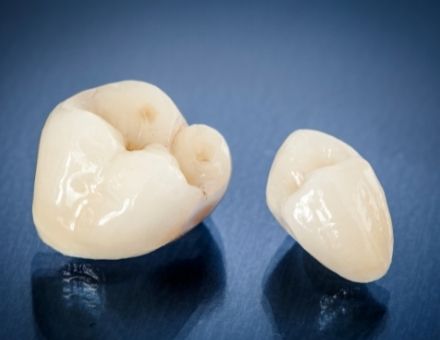
If your temporary crowns begin to smell and hurt, microscopic particles are trapped between the crowns and your teeth and breed bacteria. The bacteria affect the dentin (the layer beneath tooth enamel) and irritate it. The tooth beneath a crown can begin to decay.
Why Do Your New Dental Crowns Hurt?
Dental cement that bonds a new crown can irritate your tooth. If a tooth is already sensitive, the sensitivity may temporarily increase but gradually decrease and go away. When sensitivity does not improve, the tooth may be infected. Your dentist might need to perform root canal treatment on the tooth.
Pain When Biting with a New Crown
If you feel pain when biting or chewing with a new crown, your dentist should adjust your bite until you are comfortable. Even tooth ligaments are sometimes irritated, and your dentist would need to x-ray the roots to see their condition.
If your dentist cannot resolve sensitivity with your new crowns, we recommend that you get a second opinion to prevent the need for dental implants.
Rocky Hill, Connecticut, cosmetic dentist Dr. Thaddeus Michalski sponsors this post.
Do I Need a Tooth Root Removed That Broke During Extraction?
When my dentist removed my upper left first molar, part of the tooth root broke off. My dentist referred me to an oral surgeon to remove the root. Is there any harm in leaving the root in the socket? How common is this, anyway? I’m a little frustrated that my dentist could have referred me to a surgeon in the first place. He wounded so confident about the extraction that I trusted him. Thanks. Leander from S. Dakota
Leander,
Part of a tooth root may break during tooth removal because of the root shape or challenges removing the tooth; it is not uncommon. If a dentist realizes a root fragment is left, they may refer you to a specialist. Other dentists use an X-ray to anticipate the complexities of extraction and may refer you to a specialist upfront for tooth removal.
Do You Need to Remove a First Molar Tooth Root?
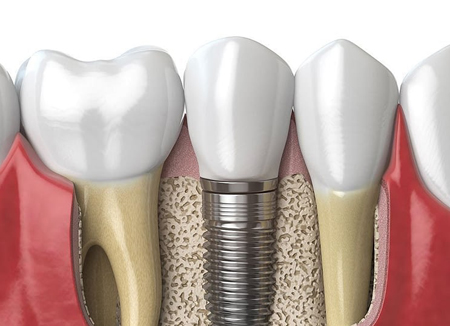
If a dentist leaves a tooth root behind after extracting an upper first molar tooth, the root can poke the sinus, resulting in sinus perforation. Leaving the tooth root in the socket for months increases complications and risks. Sinus perforation surgery can be complex and requires the skill of a specialist.
We recommend getting a second opinion right away. If the tooth root is too close to the sinus wall, a specialist may decide to leave it. Otherwise, the surgeon will remove it promptly.
If you are considering a dental implant to replace the missing first molar tooth, talk to the surgeon about it. Depending on the condition of the tooth socket and your sinus, the surgeon may recommend a bone graft or sinus augmentation procedure to prepare the site for an implant. A dental implant needs enough quality bone to support an implant crown. Caring for the socket now can prevent the need for another surgery later if appropriate. Ask the specialist about your options.
Dr. Thaddeus Michalski, a Rocky Hill, Connecticut dentist and Diplomate of the International Congress of Oral Implantologist, sponsors this post.
My Dentist Wants to Remove My New Implant
I chose the wrong dentist for implants because he placed them in shallow bone and now wants to remove them. A month after implant surgery, my dentist took an x-ray and said the implant he not healing. He wasn’t to remove it and try again. So far, the implant is not loose and doesn’t hurt. I do not trust the dentist to try again. Two weeks ago, I told the dentist I needed time to consider my options. I don’t believe I have options other than implant removal, but I need advice. What do you suggest? Thank you. Wilfredo from Elk Grove, CA
Wilfredo,
Thank your question. We understand that dental implant failure can be frustrating and disappointing. Dr. Michalski would need to examine your implant site for an accurate diagnosis, but we can provide some helpful Information.
What If Your Dentist Wants to Remove Your Implant?
If your dentist wants to remove your implant after placing it in shallow bone, it probably means that the dentist did not plan properly. Skilled implant dentists take a 3-D CT scan before implant placement to see your bone volume and determine whether it is enough for implants or if you need bone grafting.
Your dentist is responsible for these reasons:
- Low-quality standard of care
- Increasing your risk of infection or trauma
- Performing surgery that would fail
- Creating an inconvenience for you to repeat surgery
What Can You Do If About Dental Implant Failure?
You should request a refund if a dentist’s negligence causes dental implant failure. If the dentist is uncooperative, you can try the following:
- Report the issue to the state dental board
- Get advice from a medical malpractice attorney
- Get a second opinion from an advanced implant dentist
Is It Too Late to Replace a Dental Implant?
Usually, it is not too late to replace a dental implant that failed due to a lack of bone volume. A skilled implant dentist can determine whether a bone graft will help you continue treatment. The dentist must take the following steps:

- Remove the loose implant
- Perform bone grafting surgery
- Allow the graft to heal, or in some cases, immediately place the new implant
We wish you a smooth resolution.
Dr. Thaddeus Michalski, a Rocky Hill, Connecticut dentist and Diplomate of the International Congress of Oral Implantologist, sponsors this post.
Can a Dentist Save My Tooth Without a Post and Core?
I expected my dentist to tell me I needed a root canal, but he also mentioned adding a post and core. I did not fully understand her explanation about why I needed the post and score. It seemed that she was repeating something she had read in a textbook. I am anxious about a root canal, but a post and core sound like a long appointment. When are a post and care necessary? Thank you. Noah from Detroit, MI
Noah,
Thank you for your question. Dr. Michalski would need to examine and x-ray your tooth for an accurate diagnosis, but we will explain the purpose of a post and core, when it is required, and how it affects the long-term outcome of a tooth.
What Are a Dental Post and Core?
A dental post and core are materials to strengthen a tooth weakened by decay, damage, and root canal treatment. The post is a small cylinder that supports a core. The core is a dental filling material that replaces the tooth pulp and supports a dental crown.
Why Would a Dentist Recommend a Post and Core?
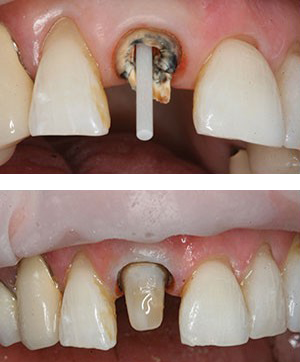
A dentist may recommend a post and core so that your tooth can support a dental crown. Sometimes, preparing your tooth for a crown requires a dentist to remove a lot of decay or damage, leaving a small amount of tooth structure. The core, or dental filling material, will replace the tooth structure and allow a dentist to cement a crown on the tooth.
The process includes these steps:
- Complete root canal therapy to remove tooth decay and infection
- Place one or two posts into the tooth
- Fill the tooth with dental material
- Build up and shape the tooth with dental bonding
- Bond a dental crown to the tooth
Will You Lose Your Tooth Without a Post and Core?
Declining a post and core may result in tooth loss for these reasons:
- You may not have enough tooth structure to support a dental crown.
- Your tooth can become weak and brittle.
- Without a post and core, you may need an extraction and dental implant
Please keep in mind that if you lose the tooth, replacing it with a dental implant and crown can cost $3,000 to $5,000 depending on these factors:
- Condition of surrounding gums and bones
- Procedures you may need in preparation for an implant
- Dental fees in your location in the U.S.
If you are unsure about your dentist’s recommendation for a post and core, schedule a second opinion with an advanced cosmetic dentist trained in root canal therapy and dental implants.
Dr. Thaddeus Michalski, a Rocky Hill, Connecticut dentist and Diplomate of the International Congress of Oral Implantologist, sponsors this post.
What Are the Types of Bone Grafting for Dental Implants?
Successful dental implant placement requires sufficient jawbone volume because your bone is the foundation for dental implants. When a tooth is missing, your body resorbs the surrounding bone and uses the minerals elsewhere in the body. If you have experienced jawbone shrinkage, you may need bone grafting to build up the bone before you get dental implants.
What Are the Types of Dental Implant Bone Grafting?
Types of bone grafting for dental implants include your bone, tissue-bank human bone, animal bone, mineral bone, and synthetic bone manufactured from proteins in the body.

- Your bone (autograft) – Your chin, hip, jaw, or tibia can be a source of bone for grafting into your jawbone. Harvesting bone from another site requires surgery. Some implant dentists or oral surgeons harvest tibia bone in the office while you are under IV sedation. Harvesting bone from your hip requires hospitalization. Autografts are the most effective bone grafting because your body adapts quickly.
- Tissue bank human bone (allograft) – Reputable tissue banks supply human cadaver bone. Tissue bank grafting is less expensive than autograft. Although tissue banks screen donors, you will have the risk of infection from donor tissue, as with a blood transfusion.
- Animal bone (xenograft) – Sterilized animal bone—most often from a cow—minimizes the risk of infection. Your body absorbs the bone over time and replaces it with your bone.
- Mineral bone substitute (alloplast) – Next to bone harvested from your body, synthetic bone is the safest means of grafting. Your body will eventually absorb and replace the bone with your bone tissue.
- Recombinant gene technology-derived protein – Proteins naturally found in the body are used to manufacture bone synthetically. The protein is FDA approved as an alternative to an autograft.
How Long Is Dental Implant Bone Graft Healing Time?
The bone grafting healing period can take four to nine months, depending on the graft used and how your body reacts to it. After it heals, your dentist or oral surgeon will perform dental implant surgery. In some cases, such as with tooth extractions, you may receive bone grafting and implants on the same day. Your implant dentist will explain your options for bone grafting and the outcome you can expect.
Rocky Hill, Connecticut dentist Dr. Thaddeus Michalski, sponsors this post.
How Can I Find Affordable Implants for My Pop-Up Denture?
I got a bum pop-up denture from a dental school. I won’t say which school it came from, but now I know I should never have gone the cheap route. The bottom denture pops up whenever I move my tongue, yawn, or cough. I press it back down, and it pops up again. I want to be furious, but I am disappointed with myself for choosing the school. I don’t have much money, but neither am I broke. A friend recommended his dentist, but I chose the dental school figuring the instructors were supervising and I could get a good deal. Now I need affordable implants to hold the denture down. Where do I start? – Thomas from NJ
Thomas – Thank you for your question. We are glad that you are seeking professional advice before getting dental implants. Please begin by avoiding looking for a bargain or the cheapest implants.
How Can You Get Affordable Implants for an Existing Denture?
You may find affordable implants for an existing denture by scheduling a consultation with a skilled implant dentist. The dentist will examine your denture to determine why it lifts and whether the dentist can fit it for implants. Depending on the condition and quality of your denture, a dentist may be able to refit it, or you may need a new denture.
Qualifying for dental implants
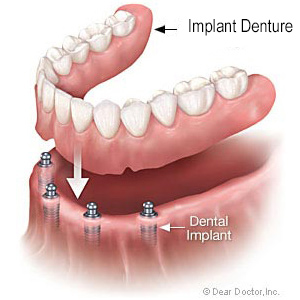 Before placing dental implants, a qualified implant dentist will take a 3-D CT scan to see your oral anatomy and bone volume. If you have worn dentures for years, you may have some bone shrinkage. The dentist will determine whether you have enough bone volume or need a bone graft to support the implants. You will get a customized treatment plan to ensure the dentist places your implants precisely and the dentures fit the implants securely.
Before placing dental implants, a qualified implant dentist will take a 3-D CT scan to see your oral anatomy and bone volume. If you have worn dentures for years, you may have some bone shrinkage. The dentist will determine whether you have enough bone volume or need a bone graft to support the implants. You will get a customized treatment plan to ensure the dentist places your implants precisely and the dentures fit the implants securely.
Getting Dental Implants that Fit Your Denture
After implant surgery, you will wear temporary replacement teeth. In three to four months, your jawbone and implants will fuse. Your implant dentist will take impressions of your mouth to ensure your existing or new denture fits your implants securely.
Expect to pay well for high-quality dentures and implants. Thorough, well-planned implant-supported dentures take time and skill. With patience and a good implant dentist, your frustration will change to satisfaction when you receive a stable, natural-looking smile.
Schedule a consultation with one or two advanced implant dentists to discuss your options and how to make treatment affordable.
Dr. Thaddeus Michalski, a Rocky Hill, Connecticut dentist and Diplomate of the International Congress of Oral Implantologist, sponsors this post.
What Can I Do About a Loose Dental Implant?
My dentist placed three implants in January, and now one of them is loose. I am concerned about what went wrong and am losing trust in my dentist. What options might a dentist give me for fixing a loose dental implant? Thank you. Manal from Seattle
Manal,
Thank you for contacting our office. Although Dr. Michalski would need to examine your implant, we can explain factors that affect treatment for a lose implant.
What Can You Do About a Loose Dental Implant?
If your dental implant is loose, you should promptly contact your implant dentist, oral surgeon, or periodontist. Your doctor will examine the implant parts and gum tissue and take a 3-D CT scan of your bone to identify why your implant is loose. Your doctor will recommend treatment based on the cause of the loose implant.
Why Get Prompt Treatment for a Loose Implant?
You should get prompt treatment for a loose dental implant because it is a threat to your oral health. Without treatment, an infection can develop and worsen. If there is any chance of saving the implant, delaying treatment will result in dental implant failure. Implant parts include an artificial root, an abutment (connector), and a dental crown. Although dental implants have a 95 percent success rate, an untreated loose implant will fail.
What Causes a Loose Dental Implant?
Faulty implant parts, gum disease, implant location, failed osseointegration (fusion of the implant and bone), and other factors can contribute to a loose dental implant. But you will need an exam from your doctor to determine the culprit.
- Implant quality, type, or size – Faulty design of the artificial root or abutment or using the wrong implant type or size can weaken and loosen it.
- Implant location – If an implant is not in the optimal place, it can loosen.
- Insufficient torque – If your doctor does not sufficiently secure the implant in your bone, it can loosen.
- Lack of bone volume – Areas of low bone volume will not support an implant.
- Gum disease – Diseased gum tissue destroys bone tissue and leaves implants without support.
- Stress on the implant – Prematurely attaching replacement teeth to implants can loosen them. Also, failure to maintain a soft-food diet can disturb implant sites and cause looseness.
- Failed osseointegration – Implants will be unstable if the jawbone and implant do not fuse.
What Is the Treatment for a Loose Dental Implant?
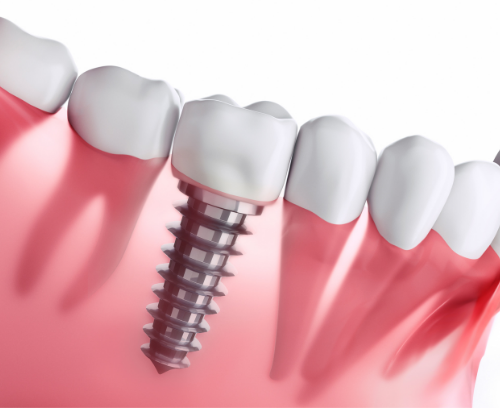 Treatment for a loose dental implant depends on the cause of looseness. Your doctor will examine the implant site and take a 3-D CT scan to examine your bone structure. Your treatment may include:
Treatment for a loose dental implant depends on the cause of looseness. Your doctor will examine the implant site and take a 3-D CT scan to examine your bone structure. Your treatment may include:
- Implant removal
- Gum disease treatment
- Bone graft
- Three to four months of healing
- Replacing the implant, possibly in a new position
- Alternative treatment
A skilled implant dentist can restore your oral health and help your dental implants succeed with proper planning.
Dr. Thaddeus Michalski, a Rocky Hill, Connecticut dentist and Diplomate of the International Congress of Oral Implantologist, sponsors this post.
Considering Dental Implants in Rocky Hill
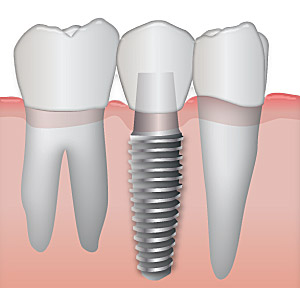 Until dental implants came into common use during the 1960s, dentures or bridges were the only options people had for replacing missing teeth. Although these are both aesthetically attractive, they could not offer a long-term solution for tooth loss. These types of prostheses can only be expected to last five to 10 years before needing to be replaced. However, with dental implants, Rocky Hill dentist Dr. Thaddeus Michalski provides a permanent solution for missing teeth.
Until dental implants came into common use during the 1960s, dentures or bridges were the only options people had for replacing missing teeth. Although these are both aesthetically attractive, they could not offer a long-term solution for tooth loss. These types of prostheses can only be expected to last five to 10 years before needing to be replaced. However, with dental implants, Rocky Hill dentist Dr. Thaddeus Michalski provides a permanent solution for missing teeth.


